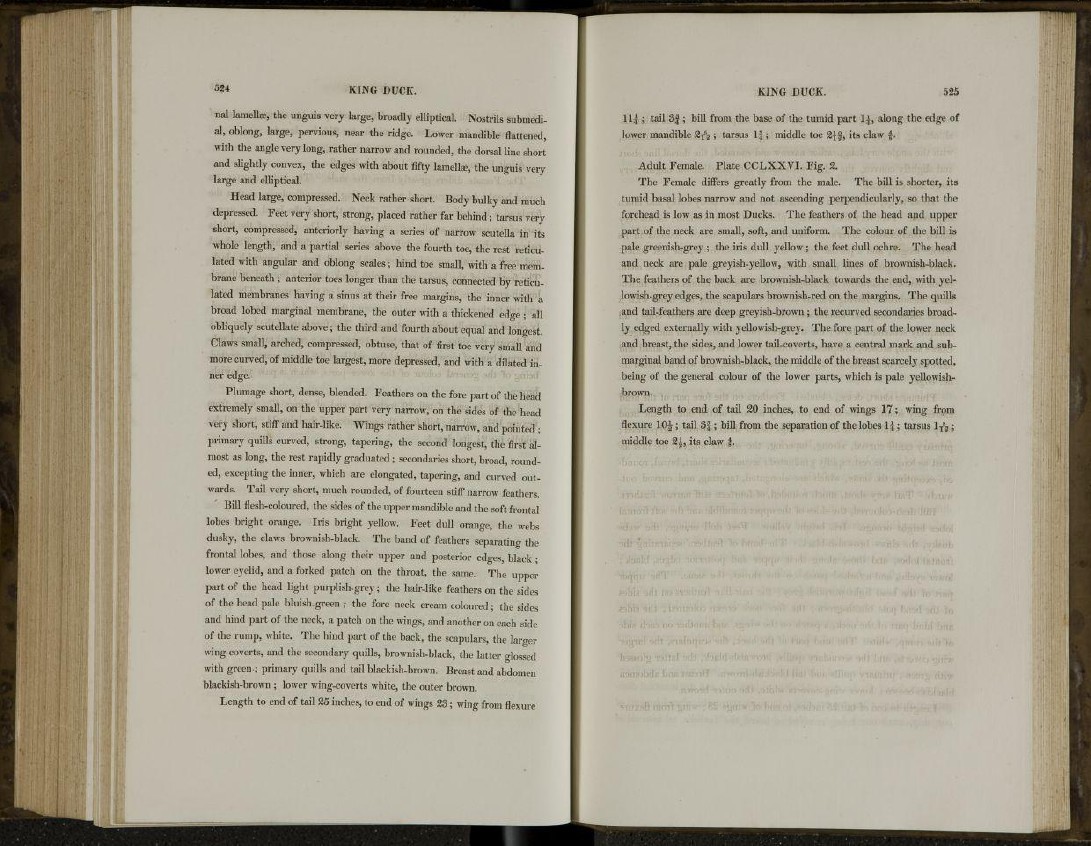
nal lamella?, the unguis very large, broadly elliptical. Nostrils submedial,
oblong, large, pervious, near the ridge. Lower mandible flattened,
with the angle very long, rather narrow and rounded, the dorsal line short
and slightly convex, the edges with about fifty lamella?, the unguis very
large and elliptical.
Head large, compressed. Neck rather short. Body bulky and much
depressed. Feet very short, strong, placed rather far behind ; tarsus very
short, compressed, anteriorly having a series of narrow scutella in its
whole length, and a partial series above the fourth toe, the rest reticulated
with angular and oblong scales; hind toe small, with a free membrane
beneath; anterior toes longer than the tarsus, connected by reticulated
membranes having a sinus at their free margins, the inner with a
broad lobed marginal membrane, the outer with a thickened edge ; all
obliquely scutellate above; the third and fourth about equal and longest.
Claws small, arched, compressed, obtuse, that of first toe very small and
more curved, of middle toe largest, more depressed, and with a dilated inner
edge.
Plumage short, dense, blended. Feathers on the fore part of the head
extremely small, on the upper part very narrow, on the sides of the head
very short, stiff and hair-like. Wings rather short, narrow, and pointed ;
primary quills curved, strong, tapering, the second longest, the first almost
as long, the rest rapidly graduated; secondaries short, broad, rounded,
excepting the inner, which are elongated, tapering, and curved outwards.
Tail very short, much rounded, of fourteen stiff narrow feathers.
Bill flesh-coloured, the sides of the upper mandible and the soft frontal
lobes bright orange. Iris bright yellow. Feet dull orange, the webs
dusky, the claws brownish-black. The hand of feathers separating the
frontal lobes, and those along their upper and posterior edges, black ;
lower eyelid, and a forked patch on the throat, the same. The upper
part of the head light purplish-grey; the hair-like feathers on the sides
of the head pale bluish-green ,• the fore neck cream coloured; the sides
and hind part of the neck, a patch on the wings, and another on each side
of the rump, white. The hind part of the back, the scapulars, the larger
wing-coverts, and the secondary quills, brownish-black, the latter glossed
with green ; primary quills and tail blackish-brown. Breast and abdomen
blackish-brown ; lower wing-coverts white, the outer brown.
Length to end of tail 25 inches, to end of wings 23; wing from flexure
11| ; tail 3 | ; bill from the base of the tumid part 1|, along the edge of
lower mandible 2 ^ ; tarsus If ; middle toe 2y§, its claw f.
Adult Female. Plate CCLXXVI. Fig. 2.
The Female differs greatly from the male. The bill is shorter, its
tumid basal lobes narrow and not ascending perpendicularly, so that the
forehead is low as in most Ducks. The feathers of the head and upper
part of the neck are small, soft, and uniform. The colour of the bill is
pale greenish-grey ; the iris dull yellow; the feet dull ochre. The head
and neck are pale greyish-yellow, with small lines of brownish-black.
The feathers of the back are brownish-black towards the end, with yellowish
grey edges, the scapulars brownish-red on the margins. The quills
and tail-feathers are deep greyish-brown ; the recurved secondaries broadly
edged externally with yellowish-grey. The fore part of the lower neck
and breast, the sides, and lower tail-coverts, have a central mark and submarginal
band of brownish-black, the middle of the breast scarcely spotted,
being of the general colour of the lower parts, which is pale yellowishbrown.
Length to end of tail 20 inches, to end of wings 17; wing from
flexure 10£; tail 3 | ; bill from the separation of the lobes l i ; tarsus 1 ^ ;
middle toe 2«|, its claw f.